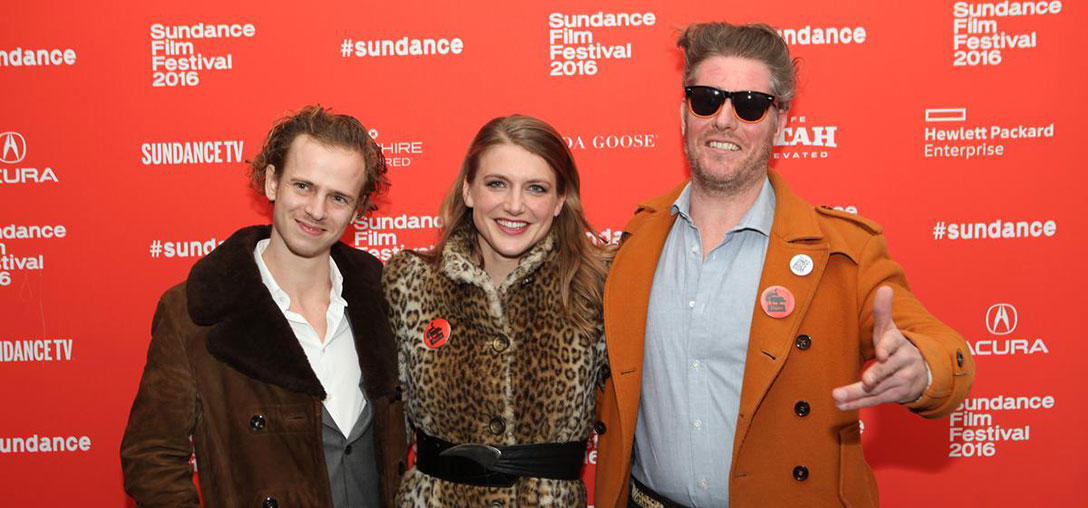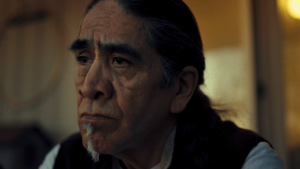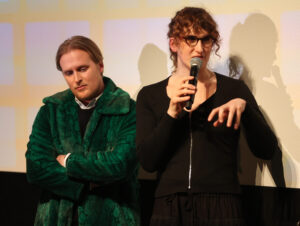Actors Steph Aerts, Charlotte Vandermeersch, and Tom Vermeir attend the Belgica premiere. ©Sundance Institute | Marisa McGrody
Sundance Institute
Sudance.org is dispatching its writers to daily screenings and events to capture the 10 days of festivities during the 2016 Sundance Film Festival in Park City, Utah. Check back each morning for roundups and insights into our experiences throughout the Festival.
Sky Ladder: The Art of Cai Guo-Qiang
By Eric Hynes
One was a rowdy, raucous, hard-rocking tale of a nightclub in Belgium, and the other was a documentary portrait of one of China’s greatest contemporary artists. Yet despite their wildly divergent milieus and methods, the opening night, World Competition films at the MARC Theater in Park City shared a preoccupation with the magnetic, ambivalent pull of family.

In Sky Ladder: The Art of Cai Guo-Qiang, which opened up the World Cinema Documentary Competition, director Kevin Macdonald shows us an artist at the top of his game, able to marshal teams of assistants and millions of dollars to accomplish awesomely ambitious fireworks shows, yet his personal and artistic grail is a half-kilometer-high alighted stairway to the sky, intended primarily for his 100 year-old grandmother to witness via iPhone.
“That’s something he talked about wanting to do when we first met,” Macdonald said during the post-screening Q&A. “For this kind of documentary that’s a portrait of the artist, you have to try and understand the work through the biography. So you’ve got two chronologies—the life, and the creation of the Sky Ladder.” Macdonald was flanked by Cai Guo-Qiang and his producers Wendi Murdoch and Fisher Stevens, both of whom invited him to the project despite his not knowing the artist or the work particularly well. But all that changed the moment they met.
“When I went to meet him in New York to discuss the film, he said, ‘To understand my work you need to come to China—and I’m going tomorrow so you should just come.’ And I said I have to go home, I have things to do, I can’t just come to China. I need a visa! And it’s very hard to get a visa. And he said, ‘Don’t worry, don’t worry. I know the ambassador.’ Literally 12 hours later I was on a plane with him to Beijing, and then went to various places around China where he was working on various projects,” Macdonald said. “I started it without really making a decision to do the film. He just said come to China.”
Guo-Qiang spoke about the strange sensation of watching himself and his life projected on screen, offering commentary on the film’s subject as if it were about someone else. “I feel the film is about a real person, a real artist. I can see the real difficulties, desires and challenges faced by this artist. And I see myself as different types of roles—as father, as husband, as son and grandson. I can also see the complex affections towards my family, hometown, and my country. And I do realize that I’m still a little boy,” he said.
To that end, he talked about the personal significance of the spectacular Sky Ladder, which is the culmination of the film, and his life’s work to date. “I’ve been creating lots of works around the world, but my grandma saw none of them. I was able to realize this project before she passed away, and was able to realize it in my hometown,” he said. “I’ve been fearing my grandma passing away since I was very little. I’ve basically been fearing seeing this day for 55 years. But then when she really left me, at least I have a ladder dedicated to her. Now I have a way to communicate to her, in another way.”
“It struck me as a great metaphor. For what, I’m not quite sure,” Macdonald added. “And I think that’s actually why it’s so powerful. At the end, I have lots of ideas of what the sky ladder means to him and to me, but I can’t quite put it into words. It’s not a simple thing. This idea of reaching beyond, reaching to the universe, connecting to higher powers. There’s something very resonant and powerful about it. But it wouldn’t be great art if you could simplify it.”
Belgica
Earlier in the evening, the Belgian director Felix van Groeningen revealed the personal connection behind the brotherly descent into sex, drugs, and rock n’ roll that is Belgica. “It’s inspired by a real bar, which my father started in 1989 and was sold to two brothers in 2000,” he said during the post-screening Q&A. Yet it’s the story of these brothers, rather than of Van Groeningen’s father, that motivates the film. When sensitive, one-eyed Jo buys the Belgica dive bar, his recently domesticated older brother Frank volunteers to help out, quickly turning the place into a destination rock club for all manner of people, a joyously seedy “Noah’s Ark” for nightcrawlers. But things turn sour as Frank becomes brutish, foolish and permanently drunk and high, neglecting his wife and children and imperiling the community that they built. Meanwhile Jo finds himself enacting familiar cycles of rage and resentment toward his brother, whom he can’t decide whether to save or punish.
“They’re like a bunch of misfits and outsiders, but somehow they create this thing that they think is beautiful—and it is in a way,” the director said. “There are problems of course, but the idea is that together they can do this, and everybody’s welcome. Let’s dance and enjoy music. But that nightlife can be very destructive if you party too much. Because drugs come in. Violence comes in. That’s how I saw that whole period when my father had the bar. It just turned. It became dark, and this place became monstrous in a way. It brought out the best in people but also the worst.”
The cast offered differing takes on the character of Frank, who see-saws between charismatically charming and undeniably repugnant throughout the film. “I hope you can feel that Frank is the loveliest guy when he’s okay. He’s so full of energy. But when he gets drunk and high he’s an animal,” said actress Charlotte Vandeermeesch, who plays Frank’s suffering but knowing wife, Isabelle. “They were a bit of a rock n’ roll couple, and they’ve been together for a while,” she continued, offering some perspective on how the characters function as a couple, despite Frank’s toxicity. “She wanted another phase in life and they decided to have children, and he cooperated on all of that, but actually he lost what he also loves, which is to have fun and go wild. She kind of understands that and lets him live. It’s finding a balance in the relationship. She’s self-sacrificial. And I know people like that. You do too. It’s love.”
On the brotherly end of things, actors Tom Vermeir (Frank) and Stef Aerts (Jo) talked about the evolution of their on- and off-screen rapport. “A couple weeks before shooting, Felix decided that we should do the film in a very heavy dialect, a strong accent from the western side of Belgium,” Aerts said. “It’s a part where Tom grew up. And because of that, I needed a dialect coach. And there was Tom. He was reading my lines word for word into my iPhone. It was a very intense job.”
“We spent a lot of time together. And [we did] some nightlife study. And that brings people together, you know?” he said with a grin. “It was a good match.”
“We had a common interest in nightlife and all the things that surrounded us,” Aerts said with a matching sly smile, evoking hijinks the likes of which are featured in the movie—though likely a bit tamer. “I didn’t know Tom before but I really know him by now. And I love him very much, like a brother.”
Norman Lear: Just Another Version of You
By Jeremy Kinser
There was a period in the 1970s when television producer Norman Lear was perhaps as famous and probably as influential as the president of the United States. In fact, his series All in the Family, centered around “lovable bigot” Archie Bunker, became such a zeitgeist-y moment when it premiered in 1971 that even then-President Richard Nixon weighed in, sharply criticizing the liberal agenda that was broadcast into American homes each week.
Norman Lear: Just Another Version of You, from Sundance vets Rachel Grady and Heidi Ewing (12th & Delaware, Jesus Camp), screened as a Documentary Premiere at the Eccles Theatre Thursday night before its broadcast on PBS’ American Masters series later this year.
During his opening remarks, Festival Founder Robert Redford paid a personal tribute to Lear. “He brought humanity, edge, humor, and vulnerability into the mainstream and I think we owe him a great debt for that,” he said to thunderous applause from the audience. “What a lot of people don’t know is when we began the Institute years ago and we were struggling financially, Norman was one of the first people to step in and help us.”

That’s merely one reason to be indebted to the man who inarguably changed the television landscape with a popular string of socially-conscious network series during the “Me Decade.” At one time Lear had six series on the air and each seemed to grow out of the previous hit: All in the Family begat Maude, about a female liberal antithesis to Bunker, which launched Good Times. Criticism of the latter over its portrayal a poverty-stricken black family led to the creation of The Jeffersons, considered groundbreaking for its focus on an affluent African-American couple. That these characters were first seen as Bunker’s neighbors brought Lear’s work full circle.
Although a framing device with a young actor portraying Lear as a young boy doesn’t add much to the narrative, Grady and Ewing incorporate fascinating archival footage of Lear rehearsing (and sometimes arguing with) his casts, as well as new interviews with the man and his family and peers to create an indelible portrait of one of the entertainment industry’s true pioneers.
During a Q&A that followed the screening, Lear announced to the enthralled crowd, “If we could all of us find the largest bed and get into bed together, it would express how I’m feeling.” The sentiment was definitely mutual.
Other People
By Jeremy Kinser
Sharply-observed performances and an eye for small amusing details highlight Other People, the debut directorial effort from Chris Kelly, which premiered Thursday night at the Eccles Theatre in the U.S. Dramatic competition.
A writer on Broad City and Saturday Night Live, Kelly not only enlisted a group of veteran comedy performers, he also mined his own life for a very personal dramedy. Jesse Plemons (a young Phillip Seymour Hoffman doppelganger known for his work on the series Fargo and in the recent Black Mass) offers a multi-layered performance as David, who sets aside his boyfriend in New York and dreams of writing for a TV series, to return home to Sacramento to help care for his terminally-ill mother (Molly Shannon, in a terrific dramatic departure) for New Year’s. Mirroring the continued rejection he faces professionally is his strained relationship with his father (Bradley Whitford), who has trouble accepting that David is gay.
During the Q&A that followed the screening, Kelly addressed what an audience member described as the film’s “mood swings” between comedy and drama. “That’s what I remember,” he shared. “I remember laughing so hard and then we’d go fill out end-of-life paperwork.” He added that when his own mother was dying, the two would experience a very horrible, depressing moment, then she’d break the tension by announcing she’d just tried medical marijuana.
Kelly also doesn’t hold back on David’s romantic life. An unflinching sex scene between David and his boyfriend Paul (Zach Woods) caused several audience members to walk out.
Fourteen-year-old J.J. Toyah (who’s appeared on Glee) not only stole scenes as a precocious, flamboyant young boy who performs in drag to entertain at his father’s birthday party, he pretty much swiped the Q&A from the better-known actors on stage. “You better use color and paint a picture, honey,” he proclaimed, encouraging people to follow their own dreams.




